D&D.Sci August 2021 Evaluation and Ruleset
post by abstractapplic · 2021-08-23T22:49:20.528Z · LW · GW · 3 commentsContents
Ruleset Mana types Solar Lunar Earth and Ocean Breeze Flame Ash Void Doom Spite Strategy Reflections Scheduling None 3 comments
This is a followup to the D&D.Sci post [LW · GW] I made ten days ago; if you haven’t already read it, you should do so now before spoiling yourself.
Here is the web interactive I built to let you evaluate your solution; below is an explanation of the rules used to generate the dataset. You’ll probably want to test your answer before reading any further.
Ruleset
Below is a summary of how the dataset works; full generation code is available here.
(Note: to make writing this easier, I’m using standard D&D dice notation, in which “4d8+3” means “roll four eight-sided dice, sum the results, then add three”.)
Mana types
Solar
Solar is the strongest and most complicated mana type. It can be decomposed into an average (40), a small amount of random noise (+ 1d2 - 1d2), two seasonality components, and the effects of distant supernovae.
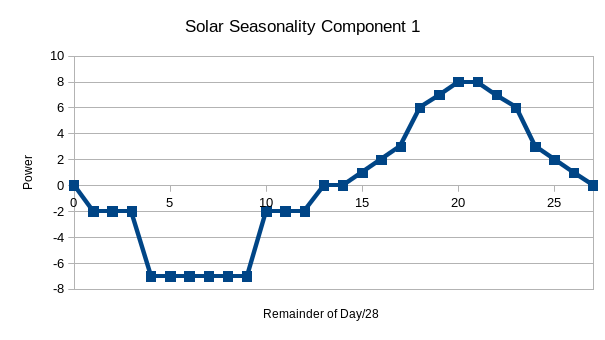
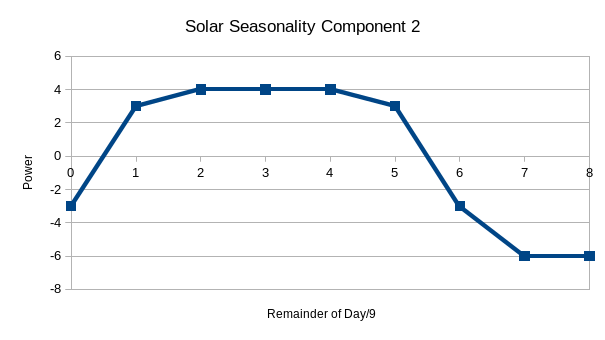
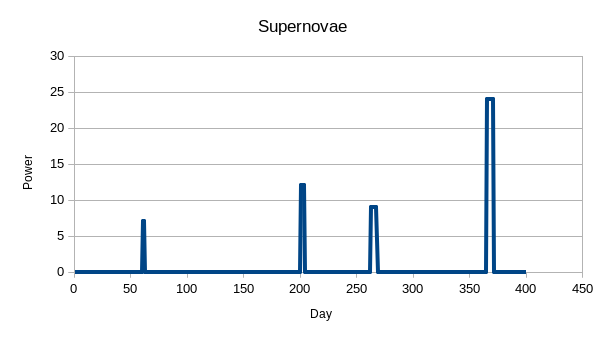
The power of Solar on Day 384 is 45 + 1d2 - 1d2
Lunar
The moon reflects and inverts the effects of the sun, with a delay. It provides a power of 75 minus the amount of Solar power 14 days ago.
The power of Lunar on Day 384 is 16, because the power of Solar on Day 370 was 59.
Earth and Ocean
Earth and Ocean combine to create the World. World Mana can be decomposed into an average (68), some random noise (1d4 - 1d4), and a seasonality effect.
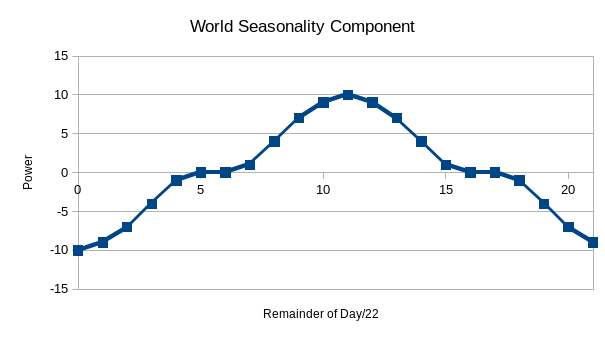
On a given day, Earth takes (15+1d80)% of World Mana, rounded down; Ocean gets the rest.
The combined power of Earth and Ocean on Day 384 is 77 + 1d4 - 1d4.
Breeze
The breeze varies, as does its variance. It is composed of an average (13), and some random noise which varies seasonally (1dN - 1dN, where N is given in the graph below).
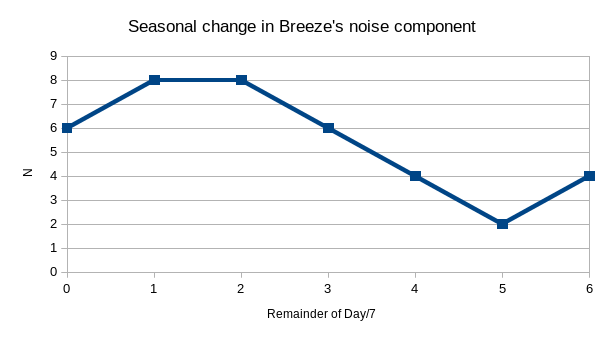
The power of Breeze on Day 384 is 13 + 1d4 - 1d4
Flame
Flame catches, sputters and starts, building and waning randomly. Today’s Flame mana is yesterday’s, minus 25% (rounded down), plus the lowest of two d20 rolls.
The spread of possibilities at Day 384 looks like this:
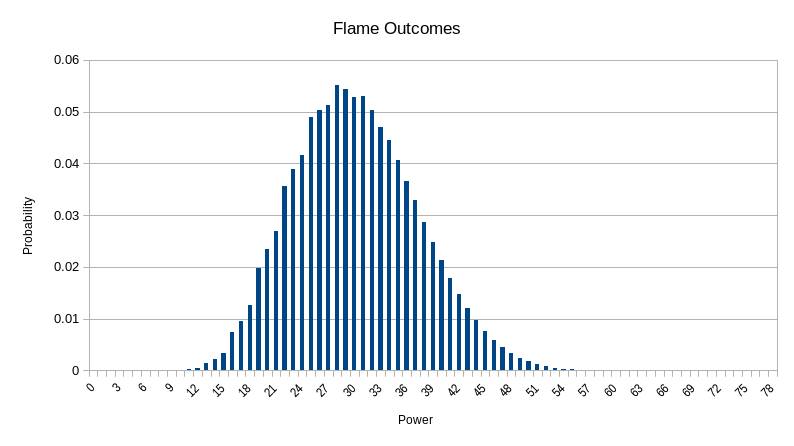
Ash
Ash is what remains when Flame is extinguished. Today’s Ash is the 25% removed from yesterday’s Flame.
The spread of possibilities at Day 384 looks like this:
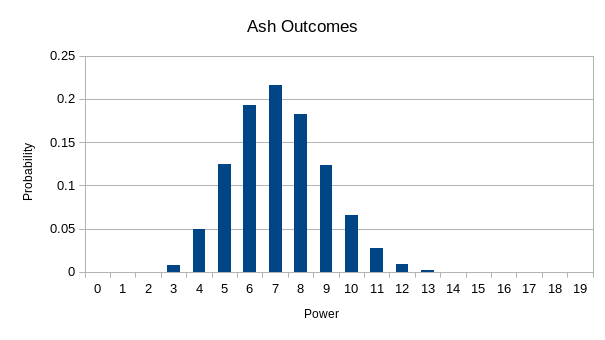
Void
Void is timeless; all motion within it is random, and all apparent trends or correspondences are merely noise. The power of Void on Day 384 – and all other days – is 24+1d8-1d8.
Doom
Doom builds gradually, then diminishes sharply as it is fulfilled. On a typical day, it can be decomposed into a starting point (24), some random noise (1d6), and a jagged seasonality effect.

However, there have been four recorded days – 34, 91, 181 and 249 – where the die rolled an impossible value. There’s a 99% chance that this is due to natural disasters, to Morgan’s pure heart and optimism making him slightly unreliable at quantifying Doom flows, or to some other innocuous explanation . . . and a 1% chance that this is due to the demon lord Astaroth modifying Doom whenever he detects a mortal using it in a ritual. As such, the power of Doom on Day 384 has a 99% chance of being 27+1d6, and a 1% chance of being one unit greater than whatever other mana flow Morgan channels.
(In my defense, I did literally call it ‘Doom’.)
Spite
Spite lays dormant, then explodes briefly, only to become silent again. Its default power is 0; to this we add 13, 7, 18 and 6 at 4-, 5-, 7- and 14-day intervals respectively.
On Day 384, Spite is 0.
Strategy
The only strategy which ensures Morgan’s success is using Earth and Ocean. However, you don’t have to share his priorities, and you had no way of knowing that there would be no supernova effect on Day 384. As such, taking an unknown risk to gain an unknown benefit in the form of Doom and Solar is also a not-strictly-dominated answer; for that matter, you could also prioritize best-case outcomes over guaranteed successes by suggesting Solar and Earth, or sabotage the ritual by advising him to use (to give one example) Lunar and Doom.
Reflections
The premise for this challenge was specified by GuySrinivasan, as a prize for winning [LW · GW] an earlier game [LW · GW]. He asked for a scenario about chronological effects: I built a system of autocorrelations, lagging and leading indicators, overlapping seasonalities, transient anomalies, and factors which turn out to actually just be random, all overshadowed by the potential for Black Swan events.
One thing I did not include was any overall time trends: Morgan and Oeis’ world is naturally one of stasis, cycles, and noise. Congratulations to everyone who successfully enabled them to change it, and particular congratulations to aphyer for reaching the intended solution within three hours (!) of the challenge being posted.
Using someone else’s premise was unexpectedly pleasant: there’s a lot of fun to be had working around arbitrary but lenient constraints, and I appreciated the guarantee that at least one player would appreciate the subject matter chosen. As such, I conclude this section by soliciting both feedback on this challenge and suggestions for what you’d like to see in future ones.
Scheduling
. . . speaking of which, I’m sorry to say you’re unlikely to see much from me for a while. I’m about to begin an intense and protracted piece of contract-work, and I don’t know how much attention I’ll be able to spare for this hobby of mine. I hope to get the next entry done sometime in October, but it’s entirely possible this will be the last D&D.Sci challenge posted this year.
(If this state of affairs bothers you, you are warmly encouraged to amend it: all my work is public domain, and I never planned to be the sole custodian of this genre. I look forward to investigating whatever scenarios you find the time and inspiration to construct.)
3 comments
Comments sorted by top scores.
comment by SarahSrinivasan (GuySrinivasan) · 2021-08-24T00:44:04.718Z · LW(p) · GW(p)
Thank you for all your efforts so far! These have been enjoyable and instructive. As expected, I enjoyed this one. :D
I was a little worried about Doom, but not enough, it seems. And I think it was entirely fair to make Doom work as it does. The thematic naming of the rest is a plenty suggestive clue.
Let me jot down what I remember learning:
- the autocorrelation coefficient of random walks tend to hover around 0.42
- it's hard to get large coefficients accidentally, so tossing tons of series together and asking for any pairs that see nontrivial correlation is a decent discovery method
- once again, if fitting parameters to a sum of two functions both of which have a constant term, remove one of the terms so you don't get confused by huge opposite values :D
- once again, pairwise scatterplots are super helpful for just eyeballing obvious patterns
- sums of sines overfit just as well as polynomials, in their domain. I knew this only in my head, not viscerally until now
comment by SarahSrinivasan (GuySrinivasan) · 2021-08-24T00:46:05.243Z · LW(p) · GW(p)
I have an idea and commit to implementing it in September.
comment by ADifferentAnonymous · 2021-10-07T20:20:35.533Z · LW(p) · GW(p)
Just did this, and wanted to make it known at least one person is enjoying the D&D.Sci backlog.
And agreed the Doom thing is totally fair—I saw those anomalously high values and decided it wasn't worth playing around with.